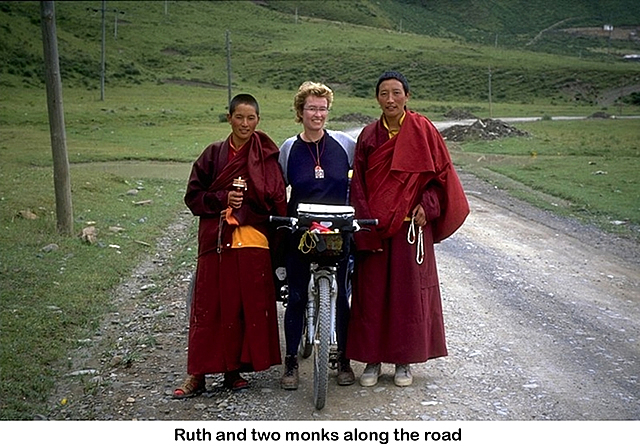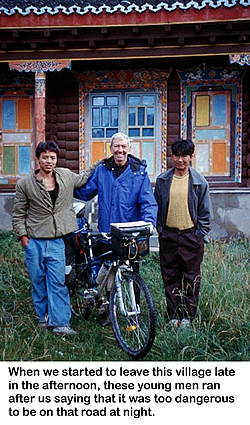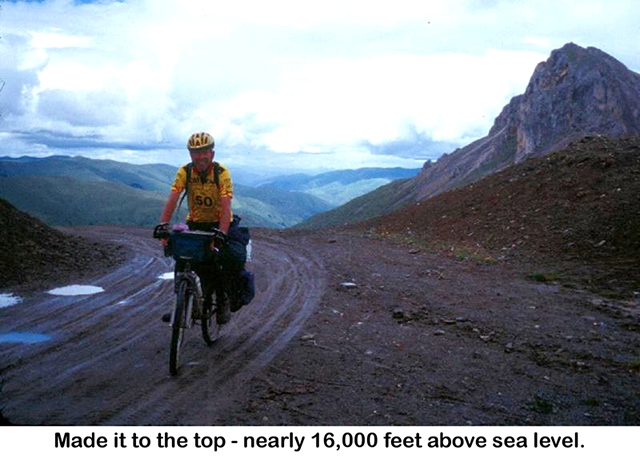
|
Club Member Spotlight Adventures with Ruth (the world's most adventurous woman) in China – Dale Blanchard
Editor
As a hook to my slideshow presentation at the January Meeting I wrote:
A couple of people wrote to me asking if they could find out how the story ended because they could not make it to the meeting. Wei Sun suggested that I write an article for the newsletter. So how did the story end? Well, before it could end it must begin. First, Ruth, and I exchanged e-mails for several months talking about our travel experiences, what we liked, what we disliked, our expectations, etc. After a few months, we both decided we could travel together and agreed that the primary focus of our trip was to be "people." We would not worry about how fast we rode, nor how many miles we went each day. When we ran out of time, we would hitchhike back to our starting point on trucks. We then set a date to meet at a hotel in Shanghai. On the night of my arrival, there was a note at the front desk. "Hi, I'm in room 502. I have maps. Knock on my door when you get here." And so it was that Ruth and I met in person for the first time. That night we went over her maps and decided on a general route that would take about four weeks through the Tibetan Plateau in Western China.
The next morning we flew to Chengdu, almost the geographical center of China and the home of the largest Panda preserves in the whole country. Ruth's bike didn't survive the flight from Spain very well and arrived with both wheels badly out of true. We found a guy on the street fixing bikes, watched him work for a few minutes, and decided he could probably true up her wheels. He did at a cost of about $2.00.
A week into the trip, at the town of Seta, which I think had previous notice that we were coming, we were mobbed like rock stars. As soon as we rolled into the town square, we were completely surrounded by people crowding to get closer to see us, touch us, and hear us speak. The night before beginning our ride, we had met some folks who had traveled by bus for a shopping trip to the city where we started. When one of the women we had met earlier saw the commotion out in the town square, she realized it must be us, and came out and rescued us. It should be noted at this point that most of the people we met in this area do not consider themselves to be Chinese. They refer to themselves as Tibetan. This area was once ruled by Ghengis Kahn and over the centuries they have paid taxes to Mongolia, Tibet, China, and who knows how many local war lords? In general they do not speak Chinese. Over the course of our trip we passed through six different Tibetan dialect areas where very few people can understand more than their own dialect. Ruth had studied the Tibetan language for some time, but only one dialect, so we had to rely on smiles and sign language for most of the trip.
After Seta, over the next three weeks, we stayed in peoples' homes, put up our tents next to black nomad tents made of yak hair, and camped in a monastery expressly for nuns. (The interview with the head lama to decide if we would be allowed to stay there lasted the better part of an hour.) Late one afternoon we were rescued by townfolk as we started out of a village, because they thought it was too dangerous for us to head out into that particular area late in the day. "There are bandits out there at night." Another time we ended up under house arrest because we stopped in a village that was closed to foreigners. (I don't remember Ruth ever saying anything about the perils of closed areas.) Still later we played a dice-directed drinking game with the Chief of Police in another village. (He was too hung over to see us off the next morning, but the rest of the village came out to wish us well.) We ate a lot of strange food, tsampa being the most memorable. Tsampa is made by mixing yak tea and yak butter with roasted barley flour and mixing it with your fingers in a bowl until it is the consistency of stiff cookie dough. Then you eat it. http://en.wikipedia.org/wiki/Tsampa I think it was about day two when Ruth and I talked about feeling embarrassed that these people, whose incredible hospitality we were enjoying, universally refused to accept payment of any kind when we stayed in their homes and ate their food. We both felt we were rich westerners receiving unbelievable generosity from people who would probably never own anything half as expensive as our bicycles. Fortunately, we discovered that every home had a shrine where we could leave offerings to Buddha. We could only hope that after we left, the people would collect those offerings to replace the food we had consumed. Perhaps my most memorable memory came near the end of our trip with only a couple of days of riding left. On our fully-loaded mountain bikes we were making our way up a steep, dirt road toward a mountain pass of just over 16,000 feet. (After the first week, almost our entire trip was spent above 12,000 feet.) From the village where we started that day, it was about 25 kilometers to the top of the pass and then another 45 km to the next village. This was going to be the hardest riding day of the trip unless we got lucky and there was a guest house at the top. Ruth asked everyone we came to if there was a guest house at the top and everyone assured us that there was.
I was in the middle of a kidney stone attack (another story for another time) and about 3 km from the pass, I needed a rest. Just off the road there was a black-tented nomad encampment. When we stopped, all the people of the camp came running up to see us. Ruth explained that we were going up and over the pass. A couple of the people took one look at me and decided most emphatically that I was not going to make it to the top. I wasn't convinced yet and asked Ruth to ask them about the guest house. I figured I could crawl three kilometers if I had to. So Ruth asked the question and everyone nodded -- except one man. He asked Ruth to repeat the question and then he turned to the rest of the group and started pulling on his sweater. It was then that it dawned on me that the word Ruth had been using for guest house really meant sweater, And, yes, of course we would need a sweater at the top of the pass! (Silly foreigners!) Just then flakes of snow began drifting down and I decided I had had enough bike riding for that day and let the people take my bike down to their camp and help me set up my tent. So, how did the story end? Well, I survived the kidney stone attack. We both survived the brutal, rough, bumpy, nearly-endless two-day truck ride back to Chendu and now, six and a half years later, Ruth and I are still friends. We exchange e-mails from time to time and invite each other to view our latest web photo albums. She has been back to the Tibetan Plateau three times since our trip, once with my ex-wife, Marie. And I still think of her as the world's most adventurous woman.Wackos and Wimps – Mike Northrup After the expected barrage of "you're a wimp it's not going to rain more than 3 inches during the ride" EMails from the Monday Morning Regulars, I've come to the conclusion that inclement weather serves to highlight the difference between two types of riders that make up a fair share of our Club's membership: wimps and wackos. So, in my never ending quest to foster new, first time ride leaders, here's a brief primer to help you, the potential ride leader, self-assess your ride leadership style: You wimps are simple folk: you wake up, you smell the threat of rain in Santa Rosa or feel the chill of a 59 degree January morning in Fremont, and, without a second thought, you cancel the ride before turning over and going back to sleep. You've never seen a hill that you like, a headwind that is your friend or a wheel that you don't shamelessly suck. You wimps can best be described by the following verse (with apologies to Wei) The mist ripples a pool in south Fremont For the record, it should come as no surprise that I proudly subscribe to the wimp style of ride leadership. You wackos, on the other hand, despite being a more complicated, special folk (that is the politically correct term, isn't it?) are easy to spot because what you lack in common sense you more than make up for in entertainment value! Some signs that you fall in the wacko camp:
Wackos and wimps--we are the nose tackles and field goal kickers of the cycling world! |
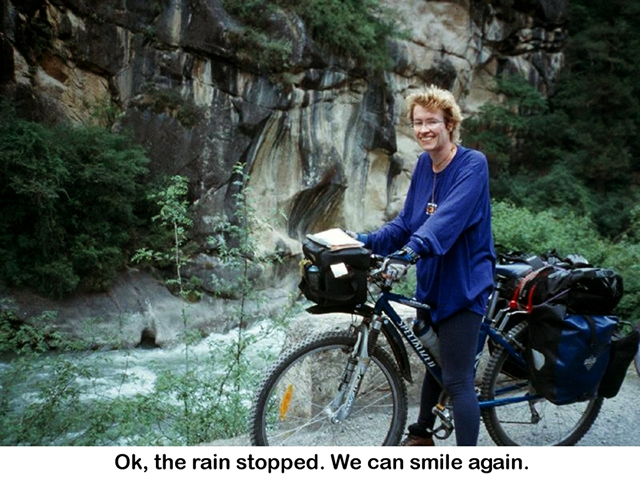
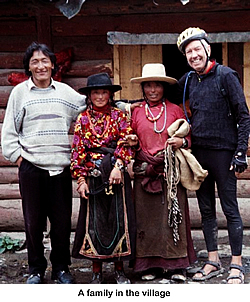 It is well that we had previously decided people were to be the focus of our trip because it turned out that we were very popular everywhere we went. In addition to these people being genuinely hospitable and generous, I'm sure we were the first westerners most of these folks had ever seen and it seemed everyone wanted us to stop and talk to them. Talking almost always involved tea, and every few miles someone would come out to the road and invite us in to have tea with them.
It is well that we had previously decided people were to be the focus of our trip because it turned out that we were very popular everywhere we went. In addition to these people being genuinely hospitable and generous, I'm sure we were the first westerners most of these folks had ever seen and it seemed everyone wanted us to stop and talk to them. Talking almost always involved tea, and every few miles someone would come out to the road and invite us in to have tea with them.